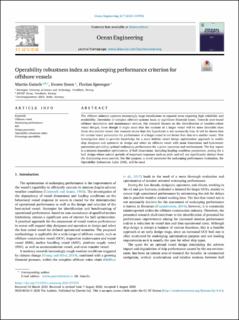| dc.contributor.author | Gutsch, Martin | |
| dc.contributor.author | Steen, Sverre | |
| dc.contributor.author | Sprenger, Florian | |
| dc.date.accessioned | 2020-09-07T09:23:52Z | |
| dc.date.available | 2020-09-07T09:23:52Z | |
| dc.date.created | 2020-08-28T15:14:11Z | |
| dc.date.issued | 2020 | |
| dc.identifier.citation | Ocean Engineering. 2020, 217 | en_US |
| dc.identifier.issn | 0029-8018 | |
| dc.identifier.uri | https://hdl.handle.net/11250/2676601 | |
| dc.description.abstract | The offshore industry operates increasingly large installations in exposed areas requiring high reliability and availability. Downtime of complex offshore systems leads to significant financial losses. Towards year-round offshore installation and maintenance service, this research focuses on the identification of weather-robust vessel designs. Even though it might seem that the motions of a larger vessel will be more favorable than those of a smaller vessel, this research shows that this hypothesis is not necessarily true. It will be shown that for certain vessel parameters the performance of a larger vessel is not better than that of a smaller vessel. This investigation aims to provide knowledge for a more holistic vessel design optimization approach to enable ship designers and operators to design and select an offshore vessel with main dimensions and hydrostatic parameters providing optimal seakeeping performance for a given operation and environment. The key aspect is a mission-dependent optimization of hull dimensions, including loading condition parameters, aiming for a hull design where natural periods of important responses such as pitch and roll are significantly distinct from the dominating wave periods. For this purpose, a novel parameter for seakeeping performance evaluation, the Operability Robustness Index (ORI), will be used. | en_US |
| dc.language.iso | eng | en_US |
| dc.publisher | Elsevier | en_US |
| dc.rights | Navngivelse 4.0 Internasjonal | * |
| dc.rights.uri | http://creativecommons.org/licenses/by/4.0/deed.no | * |
| dc.title | Operability robustness index as seakeeping performance criterion for offshore vessels | en_US |
| dc.type | Peer reviewed | en_US |
| dc.type | Journal article | en_US |
| dc.description.version | publishedVersion | en_US |
| dc.source.volume | 217 | en_US |
| dc.source.journal | Ocean Engineering | en_US |
| dc.identifier.doi | 10.1016/j.oceaneng.2020.107931 | |
| dc.identifier.cristin | 1825824 | |
| dc.description.localcode | This is an open access article distributed under the terms of the Creative Commons CC-BY license, which permits unrestricted use, distribution, and reproduction in any medium, provided the original work is properly cited. You are not required to obtain permission to reuse this article. | en_US |
| cristin.ispublished | true | |
| cristin.fulltext | original | |
| cristin.qualitycode | 1 | |

